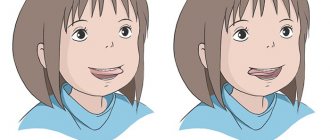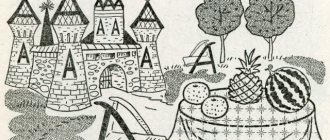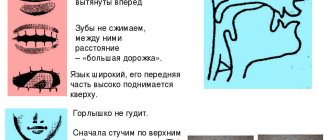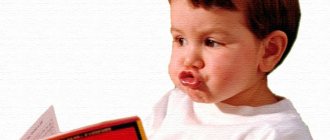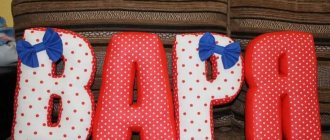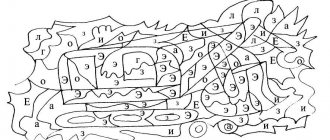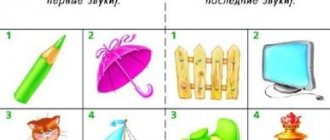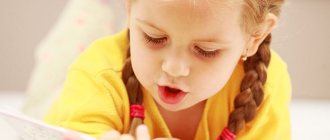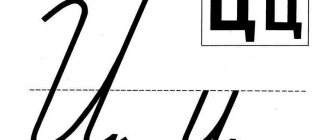Article:
Goal: development of reading skills, development of phonemic hearing, development of memory and attention, development of motor functions.
Coding development. Formation of the ability to determine the location of sound in a word, development of grapho-motor functions. Materials : worksheet, simple and colored pencils, counting sticks and buttons.
Lesson plan.
1. Introduction to the topic. 2. Development of the articulatory apparatus. Pure talk. 3. Fixing the image of the letter. Letter Y. 4. Development of phonemic hearing. A game. Guess the sound. 5. Outdoor game. Days of the week. 6. Learning to read. Words. 7. Work on proposals. Proposal scheme. 8. Development of phonemic hearing. Repeat a series of syllables. 9. Massage break. Cones. 10. Development of attention. Find the words. 11. Lexico-grammatical structure of speech. Offers. 12. Dictation. Offers. 13. Finger gymnastics. Spider. 14. Preparing your hand for writing. Fly agarics. 15. Summary.
Progress of the lesson.
“What does the letter “Y” look like?
Development of the articulatory apparatus. Pure talk. The teacher invites the children to repeat after him the pure sayings in a whisper and slowly. And then - loud and fast.
La-la-la - milk... (drank). Li-li-li - berries from the forest... (brought). Mo-mo-mo - let's eat... (popsicle). Ri-ri-ri - on the branches... (bullfinches). Ay-ay-ay - here comes the month... (May).
Fixing the image of the letter. Letter Y.
The teacher shows a card with the letter Y. - What letter is this, name it. — What sound does the letter Y represent? Remember the characteristics of the sound Y. - That's right, the sound Y is consonant, sonorous and always soft. - Let's make it out of sticks, so as not to forget the letter Y. Children make the letter Y from counting sticks, and make a hat for the letter from a button. —
Trace the letters Y on the worksheets.
Development of phonemic hearing. A game. Guess the sound.
- I pronounce the words. If you hear the sound y in a word, you clap your hands; if there is no sound y in the word, you don’t clap your hands. Words: may, give, house, bark, snow, light, iodine, blow, poppy, yogurt.
Outdoor game. Days of the week.
Children stand in a circle. On Monday I swam (pretend swimming) And on Tuesday I painted. (Pretend to draw.) On Wednesday I took a long time to wash my face, (we wash my face.) And on Thursday I played football. (Running in place.) On Friday I jumped, ran, (jumped.) Danced for a very long time. (We spin around in place.) And on Saturday, Sunday (claps hands.) I rested the whole day. (Children squat down with their hands under their cheeks and fall asleep.)
Learning to read. Words.
We invite children to read the syllables first on the worksheet line by line, and then in columns. - Read the syllables in a whisper, and then quickly. - Find and underline the words among the syllables. (HOWL, BARK, PARADISE, ROAR, FIGHT, SING).
Working on proposals. Proposal scheme.
- Read the sentence on the worksheet.
- Say the first word. Second. Third.
- Outline your proposal.
- What did Ira draw? (Drawing). What drawing? (Beautiful).
- Think about what kind of picture Anya drew and make up a story.
- Divide the word: DRAWN into syllables.
- Name the stressed syllable in this word. Place emphasis.
Development of phonemic hearing. Repeat a series of syllables.
The teacher and children sit on the carpet in a circle. The teacher pronounces a few syllables and throws the ball to one of the children. The child catches the ball, exactly repeats the sequence of syllables after the adult and throws the ball back. The teacher pronounces a new chain of syllables and throws the ball to another child.
All children take part in the game.
Chains of syllables: ah – oh; ouch - ouch - ouch; y - y - oh; hey - hey - hey; ouch - ouch - ouch - ouch.
Massage break. Cones.
The squirrel collected cones (we transfer the cone from one hand to the other), for the raccoon and for the mouse. One, two, three, four, five (we squeeze the cone with our palms for each count), I’ll find the cone again (we roll the cone between our palms). Three for the raccoon and three for the mouse (we squeeze the pine cone with one hand, then with the other), the rest for whom are the cones (we roll the pine cone between our palms)?
Development of attention. Find the words.
The teacher draws the children’s attention to the fourth task on the worksheet.
- Look what beautiful beads you can make from letters!
- Words were hidden in the beads. Read all the words you see.
- Color each word in any color.
- Let's remember what vowel sounds we know.
- Color the vowel circles red.
Lexico-grammatical structure of speech. Offers.
- Look at the picture, name the objects that are drawn on it.
- Color the objects that have the sound Y in their names (APPLES, COOKIES, EGGS).
- Make sentences based on the diagrams based on the picture.
Dictation. Offers.
The teacher dictates words to the children syllable by syllable.
— Mac grew up. End of sentence. What did you put at the end of the sentence (Period). What letter did you use to spell the word Mac? (Capitalized). Why? (Since this is the beginning of a sentence).
- Ira na-li-la juice. End of sentence. Underline the word in the second sentence that has three syllables.
Finger gymnastics. Spider.
Once upon a time there lived a little spider (hands together, thumbs touching). A spider ran and ran across the grass (we move our fingers on the table), Saw a large flower and climbed onto it (raise our arms up). And the flower swayed from side to side (wrists together, fingers spread, sway). Suddenly a cloud appeared in the sky (we make an oval with our hands). It began to rain heavily (we tap our fingers on the table). And the flower closed its petals (we lean our palms against each other). A strong storm has begun (we strongly swing the arms from side to side). But the sun appeared in the sky (we place one palm on top of the other with fingers spread) and drove away the cloud (we make a sharp movement to the right). The spider got out (we move our fingers and lower our hands down) and ran away (we hide our hands under the table).
Preparing your hand for writing. Fly agarics.
— Circle the fly agarics, trying not to take your hands off the sheet of paper. - Draw dots on the mushroom caps.
Summarizing.
Learning to read and write “Sounds [i], [th] and letters I, J”
Let's start our Internet lesson with a fairy tale...
“One boy drew a forest animal with long ears, large hind legs and a small tail. And he wrote down the name of the animal so that no one would doubt it. This is where the miracles began... The animal suddenly spoke!...
-Be - be - disgrace! - he said.
-Why is it disgraceful? -Ko – ko – of course! - the animal got angry. The boy was surprised: -What's the matter? Now you're bleating like a sheep, now you're clucking like a chicken... - Moo-moo-moo - you're a reader, that's who! - the animal hummed. - What did you do to me? -Nothing. Did I draw you poorly? -No, you can find out. -So what's the deal? -Z – why did you make me for – for – stuttering? I'm not a stutterer.
The boy caught himself and drew another tail, but this time to the letter I. And the animal stopped stuttering. “Thank you,” he said. – Now everyone knows that I am….
- Can you guess who the boy drew? What letters did the boy mix up?
So today we will get acquainted with these sounds and letters. The sounds are different. Compare: needle and yogurt.
What is the first sound in the word “needle”? What sound is this?... Yes, the sound [and] is a vowel sound
What is the first sound in the word "yogurt"? What are the features of the sound [th'] ? (consonant, soft, voiced).
Remember! The sound [th'] is ALWAYS SOFT and sonorous!
1. Think of words with the sound [th'] at the beginning (iod, yogi, iota), in the middle (t-shirt, watering can, snake), at the end of the word (may, tea, edge).
2. Change the words so that they denote a request, an order, an incentive to action: stands (stand), washes (my), builds (build), sings (sing), decides (decide), plays (play), repeats (repeat ), floats (swim), thinks (think).
3. Listen to the words , say where and in what position the sound [th'] : strong, jockey, puck, iodine, ruler.
4. Clap your hands once if you hear the sound [th'] in the words: fox, husky, player, face, washbasin, nightingale, bus, trolleybus, scissors, car, snake, name, tea.
How strange, the sounds are different, but the letters are almost written very, very similar. Don't get confused! It is very important to read words correctly; replacing one letter will change the meaning of the word. So that the bunny doesn't turn into a bunny ...
5. Say the word
The house on rails is right here,
He will kill everyone in five minutes. Sit down and don't yawn. Departs... (tram).
***
The doctor lives in a glass jar. He treats sores and wounds. “Oh, how it stings!”, “Oh, how it burns!” Do you recognize? This is... (iodine)
In winter the mosquitoes have fallen asleep, the bear is sleeping in its den, and somewhere in the jungle they are languishing from the heat... (yogis)
***
Guess what we sang? “Kara...” (wai). Guess what they sang to us? “Bai...” (bye). What month is it, guess?
The month of May). What's in the glass, guess? Sweet... (tea) Meet the letter I and the letter Y !
1. Look carefully at the letters, find similarities and differences.
2. Find the hidden letters I and Y. Circle them.
3. Identify the letter in the wrong position.
4. Repair the letters:
5. Highlight a familiar letter.
6. Color only those cubes on which the letter Y .
7. Color both letters I in red on the right side of the picture. Shade the letter according to the pattern in the middle of the picture. Find and color the letter I on the right side of the picture.
8. Color both letters green. Shade it. Find and color the letter Y.
9 . Connect with the letter And only those objects whose names begin with the sound [and] .
10 . Connect with the letter Y only those objects whose names begin with the sound [th'] .
11. Underline the same letter as below in the picture on the left. Circle all the letters I in the picture on the right.
12.
Letter Y
The name is “And short”
and
like I in your notebook.
So as Y
with I, write a tick at the top.
Take a green pencil and color in all the parts of the drawing in which you see the letters Y.
13. We are writing...
Learn to write beautifully here
14.
Dictionary
- Illusion - fiction, fantasy
- Illusionist - magician
- Image - the “image” of a product, service, enterprise, person
- Immunity is the body's defense reaction
- An empire is a powerful power that unites different peoples and territories into a single state
- Intelligence - mind
- Hippodrome is a sports complex for equestrian competitions.
- Research is an action in which scientists study a phenomenon.
- Iodine is a chemical element.
- Yoga is a physical exercise to keep fit. This is a special lifestyle and way of thinking.
Catchphrases or phraseological units
- To play the first violin is to play a leading role in any matter; to be a leader, a ringleader.
- Playing with fire means taking risks.
- To follow in someone's footsteps is to imitate someone; follow someone's example.
- Going against the grain - doing something contrary to those around you.
- To pour out your soul is to tell someone about something most intimate and personal.
- Looking for a needle in a haystack means looking among a large volume; to look for something that is obviously impossible to find.
- Sparks flew from the eyes - indicating the consequences of a strong blow.
I recommend reading:
- 77 Effective Educational Techniques
- Interesting...Great people who changed the world
- Holiday "Farewell, ABC!" (scenario)
- Online lesson on literary reading “M. Lermontov "Borodino"
Tags: Online Russian language reading
Tale about the letter Y
What do you know about yoga?
“What do you know about yogis?” - that was the name of the book that Mouse the mouse found in the garden. On the cover there was a picture of a naked guy - a yogi, who, as if nothing had happened, was lying on nails sticking out of the board. In other pictures, the same yogi simply stood with his bare feet on hot coals or sat frozen in a block of ice. In addition, Mouse read that yogis can go for months without eating or drinking. - Need to try! - decided Mouse. “I can imagine what will happen when mom opens the refrigerator, and I’m sitting there frozen and smiling. Or dad opens the stove, and I sit there on the coals and say: “What, I’ve never seen yoga, or what?”
To begin with, he hammered nails into the board and just lay down on them, when he immediately jumped up and started yelling at the whole garden:
Ohhhhh!!!
He ran home, took out iodine and began to smear the nail scratches on himself. And iodine burns! Mouse smears, groans, and thinks: “I’ll throw this book to the cat.” Let him be a yogi now.”
Assignment: printed letter Y for preschoolers
Examine the letter Y. Sew the letter Y in the air and once in the notebook, carefully in the cells with a simple pencil or ballpoint pen.
In cases where the child is asked to write a whole line of a letter, syllable or word, the adult gives a writing sample at the beginning of the line. If a preschooler has difficulties, then an adult can draw two approximate lines, or put reference points that the child will connect with lines, or write the entire letters, and the child will simply circle them in a different color. Calligraphy should not be required at this stage of training.
Funny poems about the letter J for children
Iodine is good, iodine is not evil. In vain you shout: “Oh-oh-oh!” — I just saw a bottle of iodine. Iodine sometimes burns, of course, but a wound smeared with iodine will heal faster. (V. Lunin)
Play, bunny, play with me. The bunny answers: “I can’t, I’m sick!” Oh-oh-oh, poor thing! (E. Blaginina)
Oh-oh-oh! - said OH-OH. - I, my friend, am completely sick! - Go for a walk! All will pass! - said AY-AY. (G. Vieru)
A yogi will never say: “Oh!” "Oh oh oh!" - the yogi will not shout. Young man, control yourself! Old, be like young! (V. Berestov)
I am on the tails of birds and animals: Here is an ermine, here is a sparrow. (E. Grigorieva)
At the “I Brief” station We were greeted with a riddle: “Read, dare and guess - How, without getting up from your seat, can you turn a tram into many trams? ...What should you skip so that you can turn a bunny into a stutterer?” One of us thought about the answer for about three minutes and answered, “Erase the hook above the letter “And short.” (S. Marshak)
The ant found a blade of grass and had a lot of trouble with it. He carries it home like a log on his back... He bends under the burden. He is already crawling with difficulty. But what a good house the Ants are building! (3. Alexandrova)
My kindergarten
Completed by: teacher - speech therapist of the highest category Evgenia Vasilievna Delman , Municipal budgetary preschool educational institution "Child Development Center - Kindergarten No. 65", Nakhodka.
Sound culture of speech.
Good speech is the most important condition for the comprehensive development of children. The richer and more correct a child’s speech, the easier it is for him to express his thoughts, the wider his opportunities for understanding the surrounding reality, the more meaningful and valuable his relationships with peers and adults are, the more active his mental development is. Therefore, it is so important to take care of the timely formation of children’s speech, its purity and correctness, preventing and correcting various violations, which are considered to be any deviations from the generally accepted norms of a given language.
The most common speech defects in preschool children are problems with sound pronunciation.
Sound correction is carried out in stages. Usually there are four main stages: preparatory, sound production, sound automation and, in cases of replacing one sound with another or mixing them, the differentiation stage.
The main form of work to correct sound pronunciation is classes, often individual, sometimes with subgroups. The duration of the lesson ranges from 15 to 30 minutes depending on the age of the children, the type and level of sound pronunciation impairment, and the individual characteristics of preschoolers (attention, memory, performance, etc.). Each lesson consists of several parts, subordinated to a common theme and objectives. Each part has a specific goal (what the teacher wants to achieve), content (games, exercises, etc.) and ends with the child summing up the teacher’s questions.
It must be taken into account that there are no absolutely identical classes, since speech defects in children and their personal qualities are different. Therefore, with the same content (exercises for articulatory gymnastics, words for automation, etc.) methods and techniques of work different. Thus, each lesson requires careful preparation from the teacher, taking into account the speech, mental, psychological and characterological characteristics of the child. I offer several classes on the sound culture of speech for older children.
Summary of a lesson on sound culture of speech in the senior group.
Topic: “Education of the correct pronunciation of the sound [th] in active speech.”
Target:
- Strengthen the skills to correctly pronounce and distinguish the sound [th].
- Practice the ability to hold the necessary postures when pronouncing the sound [th]: a) lips close to the teeth; b) teeth at a distance of 2-3 mm; c) the tip of the tongue rests forcefully on the lower incisors, the back of the tongue rises to the middle part of the palate and forms a narrow gap through which the exhaled stream of air passes; d) the soft palate is raised and pressed against the back wall of the pharynx, closing the passage into the nasal cavity; e) the vocal cords are closed and vibrate.
- Develop memory, attention, thinking, phonemic hearing.
Material:
- Pictures: parrot, beehive, cod, T-shirt, watering can, bunny, iodine, Dunno.
- Mirrors for each child.
Progress of the lesson.
- Message to the target.
- The teacher brings in a big bear. “Children, what a big bear - oh, oh, oh!” (Children repeat). “What dirty paws the bear has - ah, ah, ah!” (Children repeat).
- What is the second sound in the words: ah, oh? (What is the same sound in the words: ah, oh?) Pronounce the sound y, looking in the mirror.
- What do lips, teeth, tongue do when we pronounce the sound [th]? How does air come out when we pronounce the sound th? Is there a little voice in the throat when we pronounce the sound [th]?
- What sound is this? (consonant, voiced, soft). Prove why the sound Y is a consonant, why this sound is voiced.
- Didactic game “Repeat without mistakes.”
Ay - oh - y - y, etc.
Fizminutka:
Come on, little bunny, jump, jump, Knock with your paw, knock with your paw, Fall on the grass, fall, Lie down and rest, rest. Start jumping again! Run quickly to the Christmas tree and quickly jump back.
Name the words with the sound [th] that were encountered in our physical exercises.
Tell me where the [th] sound is in this word: at the beginning, in the middle or at the end. I have given you pictures, look at them carefully and cross out the pictures that don’t have the sound [th] in their names. (cards for each child). Mishka brought pictures. Didactic game “Look at the picture, name it correctly.” Name where the sound [th] is located in the word. You can offer to make sentences based on these pictures. Didactic game “Remember, repeat” - reproduction of a series of words (balalaika - bench - coffee pot).
Learn a nursery rhyme:
Don’t be afraid of the cold, wash yourself up to your waist.
Didactic game: “Change the word.”
Hare - bunny. Autumn - autumn. Summer is summer. Winter - winter. Spring - spring. Green is green. Sineva - blue, etc.
Lesson summary:
What sound did we learn to pronounce correctly today? Name words with the sound [th] at the beginning, in the middle and at the end of the word. (offer pictures).
Summary of a lesson on sound culture of speech in the senior group.
Topic: “Education of the correct pronunciation of the sound [l] in the active speech of children.
Program content:
- Strengthen the skills to correctly pronounce and distinguish the sound [l].
- Monitor the correct position of the organs of articulation: a) lips in a smile, teeth are visible; b) teeth are brought together; c) the wide tip of the tongue is pressed against the alveoli (tubercles behind the upper teeth); d) voice is involved. By placing the back of the hand to the throat, we feel the vibration of the vocal cords; e) if a child cannot produce the sound l with the position of the organs of articulation described above, then it is necessary to induce interdental [l] in such children, in this case only the position of the tongue changes - the wide tip of the tongue is clamped between the teeth. This sound is reinforced in words and games. When a child speaks interdentally well, he should be asked to move his tongue behind his upper teeth, which children usually do easily.
- Develop attention, thinking, memory, phonemic hearing.
Material:
- Pictures for exercises.
- Mirrors for each child.
- Pictures: lamp, swallow, lily of the valley, top, saw, robe, horse, spoon, bow, puddle, moon, sheepskin coat, acorn, dove, baby, pitchfork, glasses, tables, ball, strawberry, pencil case, wolf, bottle, raft, elephant, flowerbed, bun, bottle, fir tree, village, woodpecker, goat, turkey.
Progress of the lesson: Message to the goal Riddle: My character is nasty, I grew up in a garden bed. Wherever I go, I will bring everyone to tears. (Onion). What sound does the word onion begin with? The fairy tale of "The Merry Tongue". One day, Tongue was sitting at home. He opened his house and began to look into the yard. A large turkey was walking importantly in the yard, and Vova was teasing him (show picture). He waved a red flag in front of the turkey. Suddenly the turkey pouted and gurgled angrily: “bl-bl-bl” (the teacher shows the bubbling of the turkey: puffing out his cheeks, he quickly makes lapping movements with his voice turned on), Vova was frightened of the turkey and ran away. Try to cluck with me.
Articulation of sound.
“I’ll also try to sing the turkey’s song,” said Tongue. He puffed out his cheeks, ran back and forth and squawked like a turkey: “bl-bl-bl.” Then the tongue stopped running, puffed out its cheeks, pressed its wide tail tightly to the top door and sang loudly: “l-l-l.” This song is like a turkey's song, said Tongue. Such a song is heard in people's speech, It sounds firm.
Let's sing “l-l-l” together and look in the mirror what our lips are doing. Teeth, tongue, when we pronounce the sound l. How does air flow when we pronounce the sound l? Is there a little voice in the throat when we pronounce the sound l? Consolidating the pronunciation of the sound l in the games “Steamboat” and “Plane Flies”. What is the sound of l? (Consonant, voiced, hard). Why is the sound l consonant? (Because the air does not pass freely, the tongue encounters an obstacle). Why is the sound l ringing? (because there is a little voice in the throat). Didactic game “Catch the sound”. Clap your hands to the sound l. Isolating the sound [l] among sounds. R, n, l, r, l, l, th, etc.
Didactic game “Repeat without mistakes.”
La-lo-lu, lu-lo-ly, ly-la-lo, klu-kly-kla, pla-plu-ply, sla-slo-slu, etc.
Didactic game “What did I see?”
The teacher puts 4-5 pictures on the number ladder (lamp, swallow, lily of the valley, spinning top). The called child looks and says in what order the pictures are, turns to face the children and says: “I saw a lamp, a swallow, a lily of the valley, a spinning top. The children check to see if he named it correctly. Then the teacher calls another child and changes the order of the pictures. You can gradually replace some pictures with others.
Physical exercise.
Children sit on the floor one after another and row with oars. La-la-la, la-la-la, the boat sailed merrily. Lo-lo-lo, lo-lo-lo, we raise the oar. Ly-ly-ly, ly-ly-ly, our songs are heard by everyone. Didactic game “I am the beginning, you are the word.” La - paw, lu - puddle, ly - bast, etc.
Didactic game "Saw".
Children in pairs, holding their hands crosswise, “saw wood”, reciting in time with their movements:
The saw cut, sawed off a piece, ran into a twig, burst and began, Start over.
Having formed new pairs, the children continue the game.
Memorize:
The mouse lived happily, slept on the fluff in the corner. The mouse ate bread and lard, but everything was not enough for the mouse.
Summary of the lesson.
- What sound did we learn to pronounce correctly?
- What have you learned about the sound [l]?
- Name the words where the sound [l] is at the beginning, in the middle, at the end of the word (pictures are shown).
Summary of a lesson on sound culture of speech in the senior group.
Topic: “Education of the correct pronunciation of the sound [zh] in the active speech of children.”
Target:
- Reinforce the correct pronunciation of the sound z in isolation, in syllable words, in a phrase.
- Practice the correct position of the organs of articulation for good pronunciation of the sound g: a) lips are rounded and slightly pushed forward; b) teeth are brought together; c) the wide tip of the tongue is raised to the anterior edge of the palate, but not pressed; d) in the middle of the tongue there is a not strong warm air stream, which is easily felt by the palm of the hand raised to the mouth; e) voice is involved.
- Develop attention, phonemic hearing, memory, thinking.
Material:
- Mirrors for each child.
- Pictures: toad, jacket, jasmine, pajamas, hedgehogs, bear cub, beetle, blackberry, rain, acorn, skis, knives, clothes.
- Pictures for exercises.
Progress of the lesson:
- Message to the target.
- Riddle Zhu-zhu, zhu-zhu, I’m sitting on a pole, I keep repeating the letter “w”. Knowing this letter firmly, I buzz in spring and summer.
- What sound does the beetle sing? What sound does the word beetle begin with?
Didactic game "Beehive".
Children - bees buzz loudly at first, and then calm down, pronounce the sound in front of the mirror.
Articulation of sound. What do lips, teeth, tongue do when we pronounce the sound z? How does the air stream flow? (The air does not pass freely, it encounters an obstacle - teeth, tongue) - this means this sound is a consonant.
Is this sound voiced or dull? (Sounding because there is a motor running in the neck). And this sound is always solid.
What sound? (consonant, voiced, hard).
4. Didactic game “Telegraph” (repeat the syllable table)
Zha-jo-zhu-zhi, wait-wait-wait-wait, etc.
5. Name the picture, tell me where the sound is? (at the beginning, in the middle or at the end).
6. Didactic game “Change the word.” (change the word so that the sound appears. Boot - boot, meadow, iron, step, flag, snow, debt.
Fizminutka:
On the lawn, on a daisy, a Beetle flew in a colored shirt. Zhu-zhu-zhu, zhu-zhu-zhu I'm friends with daisies. Quietly swaying in the wind, bending low and low.
Name the words with the sound w that you encountered in physical training.
7. Didactic game “Who needs what?”
The girl needs scissors. Where is the sound [zh] in the word scissors? Who needs skis, hedgehogs, bear cubs, clothes, pajamas? (Determine the position of the sound z in these words). Offer to name with the word more (this bear cub is low, and this one is even lower), words - close, narrow, young (similar).
8. Working with text.
Learn a nursery rhyme: The beetle has fallen and cannot get up, He is waiting for someone to help him.
9. Didactic game: “Beetles.”
Children pretend to be beetles, sit in their houses (on chairs) and say: “I am a beetle, I am a beetle, I live here, I buzz, I buzz.” At the teacher’s signal, the “bugs” flew into the clearing. There they fly, bask in the sun and buzz “w-w-w...”. At the signal “rain”, the “bugs” fly into the houses (onto the chairs). Summary of the lesson. What sound did we learn to pronounce correctly today? What have you learned about the sound [zh]? What is he like? Name the words in which the sound [zh] is at the beginning, in the middle, at the end of the word.
Summary of a lesson on sound culture of speech in the senior group.
Topic: “Education of the correct pronunciation of the sound [h] in the active speech of children.”
Program content:
- Reinforce the correct pronunciation of the sound [h]
- isolated, in syllables, in words, in a phrase.
- monitor the correct position of the organs of articulation: a) lips are rounded and slightly pushed forward; b) teeth at a distance of 2 mm; c) the wide tip of the tongue hits the anterior edge of the palate; d) in the middle of the tongue there is a strong short air stream, which is felt like a push of air with the palm of the hand brought to the mouth; e) if the child cannot make the sound h, in the position of the articulation organs described above, it is necessary to speak together tsh, everything, speeding up the tempo, until a good sound [ch] is obtained.
Material:
- Mirrors for each child.
- Dolls Tonechka, Valechka, Anechka, Lenochka, Lidochka.
- Pictures: car, butterfly, fishing rod, girl, quokka, ball, key, sword, stove, egg, teapot, seagull, cup, bull, spider, cookies, swing.
Progress of the lesson:
Message to the target.
Mystery.
It boils, steam comes out, and whistles, and bursts with heat, rattles the lid, knocks: - Hey, take me off! - shouts (teapot).
What sound does the word teapot begin with?
Articulation (with mirror).
What do lips, teeth, and tongue do when we pronounce the sound h?
How does air leave the mouth?
Is there a voice in the throat?
What sound is this? – consonant. Why is the h sound consonant? (because the air does not pass freely, it encounters an obstacle, the tongue prevents the air from passing through). The sound h is dull because there is no voice in the neck. This sound is always soft.
Didactic game "Train". Children sit in the carriages (on chairs placed one after another). A driver is selected to sit in the first chair. He gives the signal for the train to depart: “Uh-uh...”. The train has left. Children, making movements with their hands, say “ch-ch-ch...”. At the teacher’s “stop” signal, the train stops and the children fall silent. Then a new driver is selected and the game continues.
Didactic game "Telegraph".
Reproduction of syllable series Ach-och-uch-ich. Cha-cho-chu-chi. Chnya-chnyo-chnyu-chni, etc.
Sound selection [h]. Didactic game “Catch the sound”.
a) in syllables: cha, cha, ach, ti, at, sia, chm, is, si, ti, it, etc. b) in words: chintz, bowl, buckwheat. Sing, reading room, oven, night, lilac, now, cheek, worm, endure, dream, ask, forgive, miracle.
Working with the word.
Didactic game “Say kindly.”
Pillow - pillow, jug, finger, hut, bird, hat, vase, duck, water, etc.
Physical exercise.
Chiki-chiki-chikalochki A goose rides on a stick. Duck on a pipe, Cockerel on a booth. Bunny on a wheelbarrow. Boy on a dog.
Name the words with the sound [h] that were encountered in our physical exercises.
Didactic game “Wonderful chest”.
This chest is not simple, it is wonderful, because it contains a lot of interesting things. Everyone can find out what is in it, you just need to say the following words: “chest, chest, open your barrel. Children take turns taking pictures from the chest and naming them.
Working with a phrase.
Didactic game “Let's treat the dolls to tea.”
Children give the dolls affectionate names: Tanechka, Valechka, Anechka, Manechka.
The teacher invites the children to pour tea from the teapot into cups.
I took the kettle and poured tea into Tanya’s cup. I give Tanya a cookie.
What did Sasha do?
I poured tea from a teapot into Tanechka's cup and gave her cookies.
Learn a nursery rhyme.
There are more thickets in our Pushcha, There are more thickets in our Pushcha.
Summary of the lesson.
What sound did we learn to pronounce correctly? What words with the sound [h] do you remember, where is this sound located?
Summary of a lesson on sound culture of speech in the senior group.
Topic: “Education of the correct pronunciation of the sound [sch] in the active speech of children.
Program content:
- Consolidating the correct pronunciation of a sound in isolation, in syllables, words, in a phrase.
- Monitor the correct position of the organs of articulation: a) lips in a slight smile, teeth are visible; b) teeth are brought together; c) the wide tip of the tongue is raised to the alveoli; d) there is a strong air stream in the middle of the tongue, which is easily felt by the palm of the hand brought to the mouth; e) if the child cannot make the sound [sch], with the mouth open, you need to raise the wide tip of the tongue to the upper alveoli and, without lowering it, pronounce sh-sh-sh for a long time, you will get the sound [sch]. Or, with the same position of the organs of articulation, pronounce [shch] together.
- Develop attention, thinking, phonemic hearing.
Material:
- Mirrors for each child.
- Pictures: sorrel, cheeks, shield, bream, box, vegetables, puppy, bream, things, cloak, pike.
- Pictures for exercises.
Progress of the lesson.
Target message
Mystery:
The striped villain, Will eat any baby - Minnow, roach, bleak, Only the ruff will not swallow. (pike). What sound does the word pike begin with?
Didactic game “Who is observant?”
Articulation: invite children to pronounce the sound [ш] and look in the mirror. What do our lips, teeth, and tongue do when we pronounce the sound [ ш]? How does the air pass when we pronounce the sound [у]? Is there a voice in the throat? What sound is [u] (consonant or vowel)? The sound [ш] is consonant because the air does not pass freely and meets the barrier of the teeth and tongue. Why is the sound [u] consonant? Is the sound [u] voiced or unvoiced? The sound [ш] is dull because there is no voice in the neck.
Didactic game “Scouts” (clap your hands if you hear the sound [w] from a series of sounds): ch, shch, sh, w, ch, shch, shch, etc.; from a number of syllables: cha, schu, shu, zhi, etc.; from a number of words: puppy, table, things, doctor, puppy, hat, ticks, honest, chocolate, bloodhound.
Working with syllables.
Didactic game “Repeat without mistakes”
Scha-schu-sch, Scha-schi-sch, Shch-sch-sch-sch, etc.
Fizminutka:
The pike lived in the pool, brushed chalk, prepared cabbage soup for guests, treated the bream.
Working with words.
Didactic game “What’s missing?”
Four pictures are hung on the board with the sound [ш]. A gnome appears and removes the picture. Children close their eyes. The child must name the removed picture and name where this sound is located in this word.
Didactic game "Scouts". The teacher hides the pictures: brush, wood chip, puppy, box, ticks in different places of the room. For the search, a group of “Scouts” is allocated; everyone must bring the found object and name it. When the scout brings the item and names the item, you can repeat the name of the item in chorus with the children. And then ask those children who need to reinforce this sound in speech to repeat it.
Working with a phrase.
Making sentences based on pictures (pike, ticks, brush, puppy).
For example: I need pliers, hurry up and give them away.
Memorizing pure language.
The dandy respects the brush, The dandy cleans off the dust with the brush. If the thing is not cleaned, there will be nothing to show off in.
Summary of the lesson.
What sound did we learn to pronounce correctly today?
Name the words in which the sound [у] is at the beginning, middle, and end of the word (pictures are shown)
Summary of a lesson on sound culture of speech in the senior group.
Topic: “Education of the correct pronunciation of the sound [r] in active speech.”
Program content:
- Strengthen the skills to correctly pronounce and distinguish the sound r.
- Monitor the correct position of the organs of articulation: a) lips are in the position of the next vowel; b) teeth at a distance of several millimeters; c) the tip of the tongue is raised to the alveoli and vibrates: d) in the middle of the tongue there is a strong air stream, which is easily felt by the palm of the hand raised to the mouth.
- Develop memory, attention, thinking, phonemic hearing.
Material:
- Mirrors for each child.
- Pictures with sound r.
Progress of the lesson.
Message to the target.
Riddle: What kind of taiga animal is Midnight who loves darkness? And, like all cats in the world, they hate evil dogs! (Tiger).
How does a tiger roar?
Articulation of sound [r].
The tongue was sitting in its house. He wanted to learn how to sing an airplane engine song. He smiled, showed all his teeth, opened the house wide, turned on his voice, quickly threw his tail to the top door and let in a cold breeze. The tongue sang “r-r-r” and felt that its tail began to tremble (show). The tongue put up the piece of paper and sang “rrrr” again. The piece of paper deviated (show), the tongue inserted the vial and sang again: “rrrr.” The wind hummed in the bubble (show). The tongue was happy and said: “So I learned to sing the song of an airplane engine. After all, this is the most difficult song.”
What do the lips, teeth, and tongue do when we pronounce the sound r? How does the air flow when we pronounce the sound [r]? Is there a voice? What sound is this? (Consonant, voiced, hard). Why is the sound p consonant? Why is this sound ringing?
Didactic game "Telegraph".
(repeat the syllable table).
Ra-ro-ru, bra-bro-bru, Ro-ru-ry, bro-bru-bra, Or-ur-yr, bru-bra-bro, Ir-ar-or, bra-bro-bra, etc. d.
Fizminutka:
"Crows"
Here, under the green Christmas tree, the crows are jumping merrily Kar-kar (loudly) All day long they shouted They didn’t let the kids sleep, Kar-kar-kar (loudly) Only at night they fall silent And they all fall asleep together Kar-kar-kar (quietly).
Remember the words with the sound [r] from the physical education lesson.
Didactic game “What’s added?”
The teacher places 4 pictures with words containing the sound r on the number ladder. Children name these words and determine the position of the sound in the word. Then someone turns away, and at this time another picture is added. Then the child turns, looks and says that there is more. The pictures are partially replaced and the game continues.
Working with a phrase
Learn pure sayings. (Can be selected)
Ra-ra-ra is a high mountain. Ro-ro-ro-new feather. Ru-ru-ru- the goat gnaws the bark. Ry-ry-ry - mosquitoes are flying. Ar-ar-ar - a mosquito flies. Or-or-or - Roma has an axe. Ur-ur-ur - don't chase the chickens. Ir-ir-ir- we are for peace. Orca-orca-orca is a steep hill. Ara-ara-ara - Tamara is coming. Gra-gra-gra is a good game. Tro-tro-tro - we're going by subway.
Summary of the lesson.
- What sound did we learn to pronounce correctly today?
- What did you learn about the sound [r]?
- Name words with the sound [r] at the beginning, in the middle, at the end of words.
Riddles for children starting with the letter J
When it boils, steam comes out, and it whistles and bursts with heat, the lid rattles and knocks. - Hey, take me off! - shouts. (Kettle)
Amazing carriage! Judge for yourself: The rails are in the air, and he holds them with his hands. (Trolleybus)
In a woolen clearing, a thin-legged animal dances. A stitch creeps out from under a steel shoe. (Sewing machine)
It might break. It can be boiled, If you want, it can turn into a bird. (Egg) Tell me, who is so afraid of things, Like a dog is afraid of a stick, Like a bird is afraid of a stone? (Lazy person)
I run to my mother river and cannot remain silent. I am her own son, and was born in the spring. (Creek)
He produces sheets of Wide Latitude. Supported by strong stems One hundred rough, tenacious fruits: If you don’t get around them, you’ll find them all on yourself. (burdock)
He grew up in a field angry and prickly, There were needles in all directions. (burdock)
I am always friendly with the light. If the sun is in the window, I run along the wall from the mirror, from the puddle. (Sunny bunny)
There is a button on the head, a sieve in the nose, one hand, and even that on the back. (Kettle)

